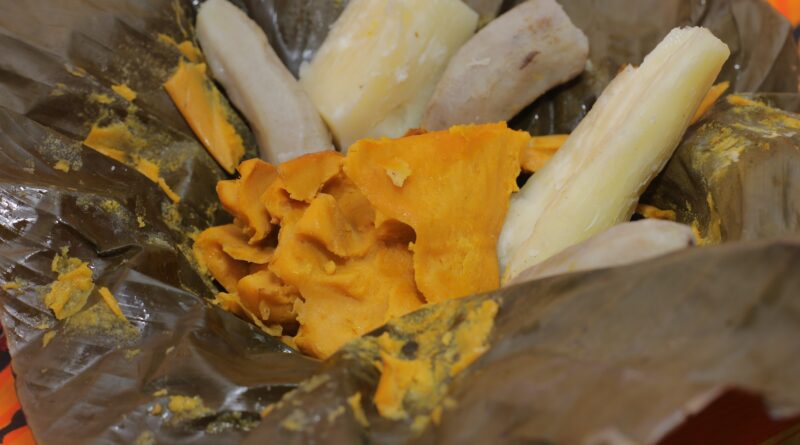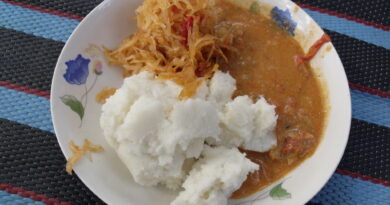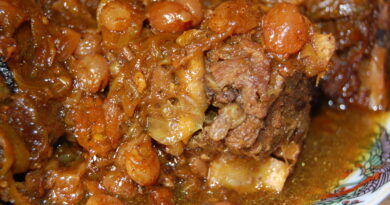Koki
The Rich Tradition of Koki: A Staple in Cameroonian Cuisine
Introduction
African cuisine is as diverse as its people, offering a tapestry of flavors, ingredients, and culinary techniques. One of the standout dishes from the rich culinary landscape of Cameroon is Koki. Known for its vibrant color, unique texture, and rich taste, Koki is a beloved dish that holds a special place in Cameroonian culture. This blog article delves into the origins, preparation, cultural significance, and variations of Koki, exploring why this dish is a cherished part of Cameroon’s culinary heritage.
The Origins of Koki
Koki, also known as Ekoki or Koki Corn, is a traditional Cameroonian dish made primarily from black-eyed peas (cowpeas) and red palm oil. The dish is believed to have originated from the southwestern region of Cameroon, where it is particularly popular among the Bakweri, Bassa, and Bakossi ethnic groups. However, its deliciousness has transcended regional boundaries, making it a favorite throughout the country.
The dish’s name, “Koki,” is derived from the local dialect and signifies the use of cowpeas as the primary ingredient. These legumes have been a staple in African diets for centuries, valued for their nutritional content and adaptability to various climates. The integration of red palm oil, another key ingredient, adds a distinct flavor and color, reflecting the agricultural bounty of the region.
The Preparation of Koki
Preparing Koki is a meticulous process that requires patience and attention to detail. The primary ingredients include black-eyed peas, red palm oil, and a variety of seasonings. Here’s a step-by-step guide to making Koki:
Ingredients
- Black-eyed peas: 4 cups
- Red palm oil: 1 cup
- Fresh spinach or pumpkin leaves (optional): 1 cup, finely chopped
- Salt: to taste
- Habanero peppers: 2-3, finely chopped (adjust to taste)
- Onions: 1 large, finely chopped
- Bouillon cubes: 1-2 (optional)
- Banana leaves: for wrapping (substitute with aluminum foil if unavailable)
Preparation Steps
- Soak and Peel the Peas: Begin by soaking the black-eyed peas in water for a few hours or overnight. This softens the peas, making them easier to peel. After soaking, rub the peas between your hands to remove the skins. Rinse thoroughly to ensure all skins are removed.
- Blend the Peas: Once peeled, blend the peas with a little water to form a smooth paste. Traditionally, this was done using a mortar and pestle, but modern kitchens often use blenders for convenience.
- Prepare the Leaves: If using banana leaves for wrapping, cut them into manageable pieces and briefly pass them over an open flame or hot water to make them pliable. This step is crucial to prevent the leaves from tearing during wrapping.
- Mix the Ingredients: In a large bowl, combine the blended peas, red palm oil, chopped spinach or pumpkin leaves (if using), chopped onions, habanero peppers, salt, and bouillon cubes. Mix thoroughly to ensure even distribution of ingredients. The mixture should have a vibrant orange color from the palm oil.
- Wrap the Mixture: Scoop a portion of the mixture onto a piece of banana leaf. Fold the leaf around the mixture to create a secure parcel. If using aluminum foil, simply wrap it tightly to prevent leakage.
- Steam the Parcels: Place the wrapped parcels in a large pot with a steam rack or a makeshift rack at the bottom. Add enough water to the pot to create steam, but not so much that it touches the parcels. Cover the pot and steam for about 1-2 hours, checking occasionally to ensure there’s enough water.
- Serve and Enjoy: Once cooked, unwrap the parcels and serve the Koki warm. It can be enjoyed on its own or paired with boiled plantains, yams, or rice.
Cultural Significance of Koki
Koki is more than just a dish; it holds deep cultural significance for the people of Cameroon. It is often prepared for special occasions, such as weddings, funerals, and festivals. The dish is also a staple during the New Year celebrations and other important communal events, where it symbolizes unity and shared heritage.
In many Cameroonian households, the preparation of Koki is a communal activity that brings families together. Elders often pass down their recipes and techniques to younger generations, ensuring that the tradition continues. The process of peeling, blending, and wrapping the Koki mixture is a labor of love that fosters a sense of togetherness and cultural continuity.
Nutritional Value of Koki
Koki is not only delicious but also highly nutritious. Black-eyed peas are a rich source of protein, dietary fiber, and essential vitamins and minerals, making Koki a balanced and wholesome meal. The addition of red palm oil, which contains healthy fats and antioxidants, enhances the dish’s nutritional profile. When combined with leafy greens like spinach or pumpkin leaves, Koki provides a good dose of vitamins A and C, iron, and calcium.
Variations of Koki
While the traditional Koki recipe remains popular, there are several regional and individual variations that reflect the diverse culinary landscape of Cameroon. These variations often incorporate local ingredients and adapt the dish to different tastes and preferences.
Koki Corn
Koki Corn is a popular variation that substitutes black-eyed peas with fresh corn kernels. The preparation process is similar, but the result is a sweeter, corn-based version of Koki. This variation is especially popular during the corn harvest season and is often served with roasted plantains or yams.
Koki Banana
Another delightful variation is Koki Banana, which includes ripe bananas in the mixture. The bananas add a subtle sweetness and a unique texture to the dish. This version is particularly popular among children and is often served as a breakfast or snack option.
Spicy Koki
For those who enjoy a bit of heat, Spicy Koki is the way to go. This variation incorporates additional spices and hot peppers, giving the dish a fiery kick. It’s a favorite among spice lovers and is often enjoyed with a cooling side dish, such as avocado slices or cucumber salad.
Koki in Popular Culture
Koki has found its way into various aspects of Cameroonian popular culture. It is frequently featured in cookbooks, food blogs, and television cooking shows, showcasing its enduring popularity. Additionally, Koki is a common sight at local markets and street food stalls, where vendors sell it freshly made to eager customers.
In recent years, Koki has also gained international recognition. Cameroonian expatriates and food enthusiasts around the world have introduced the dish to new audiences, often sharing recipes and stories through social media. This global exposure has helped to cement Koki’s status as a beloved and iconic Cameroonian delicacy.
Conclusion
Koki is a dish that embodies the rich culinary heritage and cultural diversity of Cameroon. From its humble origins to its status as a beloved national dish, Koki has captured the hearts and palates of many. Its preparation is a labor of love that brings families and communities together, preserving traditions and fostering a sense of unity.
Whether enjoyed in its traditional form or as one of its many delightful variations, Koki remains a symbol of Cameroon’s vibrant culture and culinary ingenuity. As more people discover and appreciate this unique dish, Koki’s legacy continues to grow, connecting the past with the present and future. In every bite of Koki, one can taste the rich history and communal spirit of Cameroon, making it a truly special and meaningful culinary experience.



